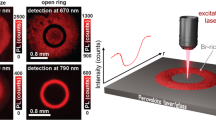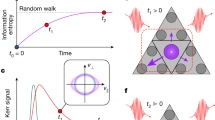Abstract
CERTAIN types of cathode-ray tubes in which the luminous spot on the fluorescent screen is moved by magnetic fields are liable to a peculiar defect, known as 'ion spot' or 'ion burn'. It is now thought that in most cases they are due to ions issuing from the thermionic cathode. This conclusion was mainly reached by inference from the composition of the ion stream which was analysed by mass-spectroscopic methods by several investigators1,2,3.
This is a preview of subscription content, access via your institution
Access options
Subscribe to this journal
Receive 51 print issues and online access
$199.00 per year
only $3.90 per issue
Buy this article
- Purchase on SpringerLink
- Instant access to full article PDF
Prices may be subject to local taxes which are calculated during checkout
Similar content being viewed by others
References
Bachman, C. H., and Carnahan, C. W., Proc. Inst. Rad. Eng., 26, 529 (1938).
Broadway, L. F., and Pearce, A. F., Proc. Phys. Soc. (London), 51, 335 (1939).
Schaefer, H., and Walcher, W., Z. Phys., 121, 679 (1943).
Author information
Authors and Affiliations
Rights and permissions
About this article
Cite this article
LIEBMANN, G. Origin of Ion Burn in Cathode-Ray Tubes. Nature 157, 228 (1946). https://doi.org/10.1038/157228a0
Issue date:
DOI: https://doi.org/10.1038/157228a0
This article is cited by
-
Quenching of Fluorescence by van der Waals Forces
Nature (1946)



